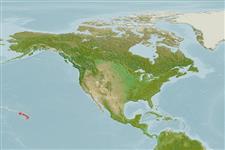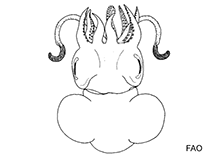Euprymna scolopes Berry, 1913
Hawaiian bobtail squid| Native range | All suitable habitat | Point map | Year 2050 |

|
| This map was computer-generated and has not yet been reviewed. |
| Euprymna scolopes AquaMaps Data sources: GBIF OBIS |
Изображение на Google | No image available for this species;
drawing shows typical species in Sepiolidae.
Классификация / Names народные названия | синонимы | CoL | ITIS | WoRMS
Cephalopoda | Sepiida | Sepiolidae | Sepiolinae
Environment: milieu / climate zone / пределы глубины / distribution range экология
; пределы глубины 0 - 1 m (ссылка 118073). Tropical; 25°N - 18°N, 170°W - 154°W
Distribution страны | регионы FAO | Ecosystems | места находок | интродукции
Eastern Central Pacific: Hawaiian Islands.
Length at first maturity / Size / Weight / Возраст
половая зрелость: Lm ? range ? - ? cm Max length : 3.0 cm ML самец/пол неопределен; (ссылка 1695)
Life cycle and mating behavior половая зрелость | размножение | нерест | Eggs | Fecundity | Larvae
Основная ссылка
ссылки | координатор | соавторы
Jereb, P. and C.F.E. Roper (eds.). 2005. (ссылка 1695)
Статус Красного Списка МСОП
(ссылка 130435: Version 2024-2)
Статус СИТЕС (ссылка 108899)
CMS (ссылка 116361)
Угроза для людей
Использование человеком
рыболовство: интереса не представляет
| FishSource |
инструменты
дополнительная информация
Max. ages / sizes
Length-weight rel.
Length-length rel.
Размерный состав
Mass conversion
численность
ресурсы в Интернет
BHL | BOLD Systems | CISTI | DiscoverLife | FAO(Publication : search) | Fishipedia | GenBank (Геном, Нуклеотид) | GloBI | Gomexsi | Google Books | Google Scholar | Google | PubMed | Tree of Life | Wikipedia (Вперёд, поиск) | Zoological Record



